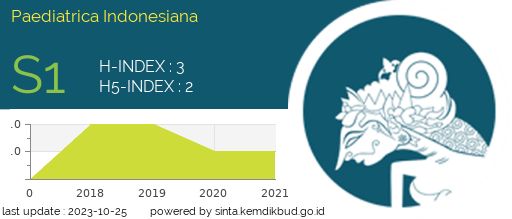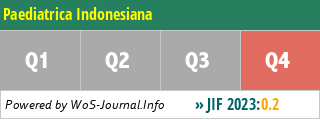Score for Neonatal Acute Physiological Evaluation with Perinatal Extension (SNAPPE II) as a predictor of mortality from neonatal sepsis
Keywords:
SNAPPE, neonatal sepsis, neonatal mortality, risk factorsAbstract
Background Sepsis is considered one of the leading causes of neonatal mortality. In the quest to reduce neonatal mortality, it is crucial to identify factors that increase the risk of death in neonates. The use of tools such as assessment scales allows us to identify neonates at higher risk of mortality. The SNAPPE II scale might be a predictive factor for mortality in this age group, could be considered as a tool to be used in all neonatal ICU (NICU). Objective To determine whether SNAPPE II, with a score of ? 40 points, is a good predictor of mortality due to neonatal sepsis.
Methods A retrospective cohort study was conducted on 162 term neonates diagnosed with neonatal sepsis at the Víctor Lazarte Echegaray Hospital, within the neonatal intermediate care unit (NIMCU) and NICU, from 2021 to 2023. The SNAPPE II scale was applied to all subjects, and scores were analyzed for potential associations with subject mortality.
Results The SNAPPE II score was associated with mortality in neonatal sepsis. Multivariable logistic regression analysis revealed a significant association at cut-off of ? 40 pints between higher score and subject mortality (aOR=1.29; 95%CI 1.13 to 1.56; P<0.001). Additionally, we found that mechanical ventilation was an independent predictor of mortality from neonatal sepsis (aOR=1.48; 95%CI 1.46 to 151.9; P<0.01).
Conclusion The SNAPPE II score with a cut-off of 40 points is a good predictor of mortality in neonatal sepsis.
References
2. Bonnard A, Zamakhshary M, Ein S, Moore A, Kim PCW. The use of the score for neonatal acute physiology-perinatal extension (SNAPPE II) in perforated necrotizing enterocolitis: could it guide therapy in newborns less than 1500 g? J Pediatr Surg. 2008;43:1170-1174. DOI: https://doi.org/10.1016/j.jpedsurg.2008.02.051
3. Arreaga LDPT, Avilés DAR, Rivera MKB, Caballero JVC. Factores de riesgo y prevención de sepsis neonatal temprana. Recimundo. 2019;3(3 esp):513-528. DOI: https://doi.org/10.26820/recimundo/3.(3.Esp).noviembre.2019.513-528
4. Glaser MA, Hughes LM, Jnah A, Newberry D. Neonatal sepsis: a review of pathophysiology and current management strategies. Adv Neonatal Care. 2021;21:49-60. DOI: https://doi.org/10.1097/ANC.0000000000000769
5. Ali A, Ariff S, Rajani R, Khowaja WH, Leghari AL, Wali S, et al. SNAPPE II Score as a predictor of neonatal mortality in NICU at a tertiary care hospital in Pakistan. Cureus. 2021;13:e20427. DOI: https://doi.org/10.7759/cureus.20427
6. Harsha SS, Archana BR. SNAPPE-II (Score for Neonatal Acute Physiology with Perinatal Extension-II) in predicting mortality and morbidity in NICU. J Clin Diagn Res. 2015;9:SC10-12. DOI: https://doi.org/10.7860/JCDR/2015/14848.6677
7. Lima A, Widen R, Vestal G, Uy D, Silbert S. A TaqMan probe-based real-time PCR assay for the rapid identification of the emerging multidrug-resistant pathogen candida auris on the BD max system. Journal of Clinical Microbiology. 2019;57: e01604-18. DOI: https://doi.org/10.1128/JCM.01604-18
8. Samanta M, Biswas C, Pal NK, Sarkar S, Goswami A, Hazra A, et al. Performance of SNAPPE-II score in neonatal sepsis: an experience from a tertiary care center. Turk J Pediatr. 2020;62:191-198. DOI: https://doi.org/10.24953/turkjped.2020.02.004
9. Lokraj S, Keshary BN, Niranjan S, Rajbhandari SR, Santosh A, Shah L. Evaluate and compare SNAP II and SNAPPE II as predictors of neonatal mortality in a neonatal intensive care unit at B.P. Koirala. Semantic Scholar. 2023. Corpus ID: 261019297.
10. Naunova-Timovska S, Jordanova O, Babinkostova Z. Using score for neonatal acute physiology perinatal extension II (SNAPPE II) in Neonates with acute kidney injury. Open Access Maced J Med Sci. 2019;7:3559-63. DOI: https://doi.org/10.3889/oamjms.2019.762
11. Jain S, Bansal A. SNAPPE II score for predicting mortality in a level II neonatal intensive care unit. Dicle Med J. 2009;36:333-5.
12. Silva MBA, Poma SLM, Campoverde ALL. Sensibilidad y Especificidad de los Índices SNAP II Y SNAPPE II como predictores de mortalidad neonatal en pacientes ingresados en una Unidad de Cuidados Intensivos Neonatales: Estudio Observacional. Revista Ecuatoriana de Pediatría. 2020;21:ículo 5:1-9. DOI: https://doi.org/10.52011/0017
13. Freundlich RE, Li G, Leis A, Engoren M. Factors associated with initiation of mechanical ventilation in patients with sepsis: retrospective observational study. Am J Crit Care. 2023;32:358-67. DOI: https://doi.org/10.4037/ajcc2023299
14. Evans L, Rhodes A, Alhazzani W, Antonelli M, Coopersmith CM, French C, et al. Surviving sepsis campaign: International Guidelines for Management of Sepsis and septic Shock 2021. Intensive Care Med. 2021;47:1181-247. DOI: https://doi.org/10.1007/s00134-021-06506-y
15. Keim G, Percy AG, Himebauch AS, Hsu JY, Christie JD, Yehya N. Acute respiratory failure-related excess mortality in pediatric sepsis. Thorax. 2023;78:1135-7. DOI: https://doi.org/10.1136/thorax-2022-219961
16. Rusmawatiningtyas D, Rahmawati A, Makrufardi F, Mardhiah N, Murni IK, Uiterwaal CSPM, et al. Factors associated with mortality of pediatric sepsis patients at the pediatric intensive care unit in a low-resource setting. BMC Pediatr. 2021;21:471. DOI: https://doi.org/10.1186/s12887-021-02945-0
17. Márquez-González H, Casanova-Bracamontes L, Muñoz-Ramírez CM, Peregrino-Bejarano L, Bolaños-Téllez B, Yáñez-Gutiérrez L. Relation between fluid overload and mortality in children with septic shock. Arch Argent Pediatr. 2019;117:105-13. DOI: https://doi.org/10.5546/aap.2019.eng.105
18. Arias-Arellano S, Cáceres-Aucatoma F, Geyson D, Segarra-Galarza K. [Risk factors associated with late-onset neonatal sepsis]. Rev Med Inst Mex Seguro Soc. 2019;57:226-31.
19. Hu Y, Chen X, Wang F, Li C, Yue W, Wei H. Risk factors of neonatal acute respiratory distress syndrome based on the montreux definition in neonates with sepsis: a retrospective case-control study. Am J Perinatol. 2024;41:1019-26. DOI: https://doi.org/10.1055/a-1788-5121
20. Kochanowicz JF, Nowicka A, Al-Saad SR, Karbowski LM, Gadzinowski J, Szpecht D. Catheter-related bloodstream infections in infants hospitalized in neonatal intensive care units: a single center study. Sci Rep. 2022;12:13679. DOI: httsp://doi.org/10.1038/s41598-022-17820-w
21. Catho G, Rosa Mangeret F, Sauvan V, Chraïti MN, Pfister R, Baud O, et al. Risk of catheter-associated bloodstream infection by catheter type in a neonatal intensive care unit: a large cohort study of more than 1100 intravascular catheters. J Hosp Infect. 2023;139:6-10. DOI: https://doi.org/10.1016/j.jhin.2023.06.011
22. Ramírez-Valdivia JM, Pérez-Molina JJ, Villaseñor-Sierra A, Troyo-Sanromán R, Gómez-Ruiz LM, Farfán-Covarrubias JL. Risk factors associated to neonatal cross-infection. Rev Med Inst Mex Seguro Soc. 2009;47:489-92.
23. Webbe JWH, Longford N, Battersby C, Oughham K, Uthaya SN, Modi N, et al. Outcomes in relation to early parenteral nutrition use in preterm neonates born between 30 and 33 weeks’ gestation: a propensity score matched observational study. Arch Dis Child Fetal Neonatal Ed. 2022;107:131-6. DOI: https://doi.org/10.1136/archdischild-2021-321643
24. Zingg W, Tomaske M, Martin M. Risk of parenteral nutrition in neonates--an overview. Nutrients. 2012;4:1490-503. DOI: https://doi.org/10.3390/nu4101490
Downloads
Published
How to Cite
Issue
Section
License
Authors who publish with this journal agree to the following terms:
Authors retain copyright and grant the journal right of first publication with the work simultaneously licensed under a Creative Commons Attribution License that allows others to share the work with an acknowledgement of the work's authorship and initial publication in this journal.
Authors are able to enter into separate, additional contractual arrangements for the non-exclusive distribution of the journal's published version of the work (e.g., post it to an institutional repository or publish it in a book), with an acknowledgement of its initial publication in this journal.
Accepted 2025-03-19
Published 2025-04-25













